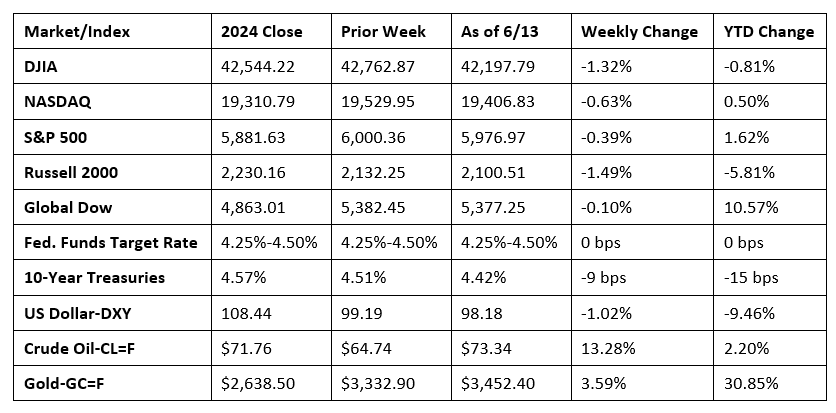Unrest in the Middle East dragged stock values lower last week, while pushing gold and crude oil prices higher. For much of the week, investors focused on trade talks between the U.S. and China, which ultimately did not result in a significant breakthrough in trade relations and left tariffs at relatively elevated levels. However, favorable inflation data for May offered some encouragement for investors as stocks moved higher last Thursday. Nevertheless, escalating tensions in the Middle East resulted in a sharp drop in stocks last Friday, while crude oil prices jumped over 13% last week. Gold rose more than 3.5%, with prices nearing an April record high as investors sought safety amid rising geopolitical tensions. Among the market sectors, energy and health care outperformed, while financials, industrials, and consumer staples declined.

Chart reflects price changes, not total return. Because it does not include dividends or splits, it should not be used to benchmark performance of specific investments.
Last Week’s Economic News
- Consumer prices ticked up 0.1% in May, according to the latest Consumer Price Index (CPI). Prices for shelter rose 0.3% in May and were the largest contributor to the overall monthly increase. Food prices increased 0.3%, while energy prices fell 1.0% in May as prices for gasoline declined. Consumer prices less food and energy rose 0.1% in May, following a 0.2% increase in April. Over the last 12 months, the CPI increased 2.4%. Inflationary pressures have remained somewhat muted, despite President Trump’s sweeping tariffs, although some economists expect price pressures to heat up over the second half of the year. Also of note, CPI data will come under closer scrutiny moving forward as the Bureau of Labor Statistics announced the suspension of data collection in three cities due to waning resources.
- Wholesale prices rose 0.1% in May after declining 0.2% in April, according to the latest Producer Price Index (PPI). Since May 2024, the PPI has risen 2.6%. Prices for services advanced 0.1% in May, while prices for goods rose 0.2%. Prices less foods, energy, and trade services edged up 0.1% in May and 2.7% over the last 12 months.
- The monthly federal deficit was $316 billion in May following April’s $258 billion surplus. In May, total receipts were $371 billion, while total outlays were $687 billion. For fiscal year 2025, the deficit sits at $1,365 billion, compared to $1,202 billion over the same period in the prior fiscal year. In FY25, total receipts equaled $3,482 billion, while total outlays were $4,846 billion.
- The national average retail price for regular gasoline was $3.108 per gallon on June 9, $0.019 per gallon below the prior week’s price and $0.321 per gallon less than a year ago. Also, as of June 9, the East Coast price decreased $0.027 to $2.949 per gallon; the Midwest price ticked down $0.001 to $2.966 per gallon; the Gulf Coast price increased $0.014 to $2.716 per gallon; the Rocky Mountain price fell $0.055 to $3.085 per gallon; and the West Coast price declined $0.053 to $4.154 per gallon.
- For the week ended June 7, there were 248,000 new claims for unemployment insurance, unchanged from the previous week’s level, which was revised up by 1,000. According to the Department of Labor, the advance rate for insured unemployment claims for the week ended May 31 was 1.3%, an increase of 0.1 percentage point from the previous week’s rate. The advance number of those receiving unemployment insurance benefits during the week ended May 31 was 1,956,000, an increase of 54,000 from the previous week’s level, which was revised down by 2,000. This is the highest level for insured unemployment since November 13, 2021, when it was 1,970,000. States and territories with the highest insured unemployment rates for the week ended May 24 were New Jersey (2.2%), Washington (2.1%), California (2.0%), Rhode Island (2.0%), Massachusetts (1.9%), the District of Columbia (1.8%), Illinois (1.6%), Nevada (1.6%), New York (1.6%), Oregon (1.6%), and Puerto Rico (1.6%). The largest increases in initial claims for unemployment insurance for the week ended May 31 were in Kentucky (+3,967), Minnesota (+2,364), Tennessee (+1,764), Ohio (+1,271), and North Dakota (+593), while the largest decreases were in Michigan (-3,783), Massachusetts (-1,585), Florida (-1,456), Iowa (-1,074), and Nebraska (-1,065).
Eye on the Week Ahead
The Federal Open Market Committee meets this week. A few months ago, the consensus was that the Fed would decrease interest rates following their June meeting. However, recent economic indicators relied upon by the Committee tend to point to maintaining the current federal funds rate range.
The Week Ahead

The information provided is obtained from sources believed to be reliable. Forecasts cannot be guaranteed. Past performance is not a guarantee of future results.
© 2021 Broadridge Financial Solutions, Inc. All Rights Reserved.